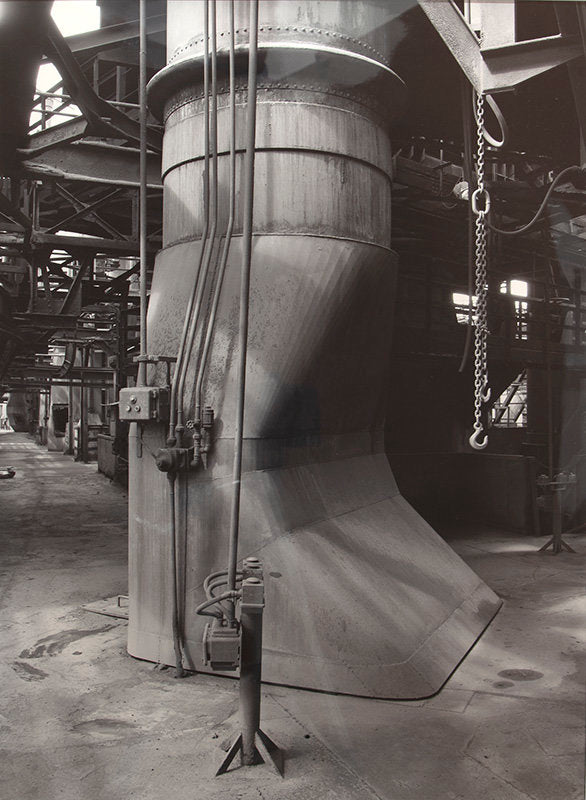![FFOTO-John Vanderpant-Honestly, Honesty [variant 2]](http://ffoto.com/cdn/shop/products/61315a1245c0e08bba3788bd75216a6cj_512x.jpg?v=1554156080)

Bernd & Hilla Becher
Pipe Detail, Steelplant, Völklingen, Saarland, Germany by Bernd & Hilla Becher
 Toronto, ON)
Toronto, ON)
Learn about our Shipping & Returns policy.
Have a question? Read our FAQ.
- Artwork Info
- About the Artist
- Artist Docs
- Artist News
-
1986
Ferrotyped gelatin silver print
Signed, titled, dated, editioned, and annotated "E8" and "R", in pencil, au verso
Printed circa 1986
Edition of 5 (#1/5)
Unframed - Bernd Becher and Hilla Becher (née Wobeser), (respectively, born August 20, 1931, Siegen, Germany—died June 22, 2007, Rostock; born September 2, 1934, Potsdam, Germany—died October 10, 2015, Düsseldorf), German photographers known for their straightforward black-and-white images of types of industrial buildings. For nearly five decades, the couple systematically photographed individual industrial structures—water towers, blast furnaces, grain elevators, framework (half-timber) houses—most of which dated to the 19th century and have since been demolished.
Bernd studied painting and lithography at the Staatliche Kunstakademie in Stuttgart, Germany, from 1953 to 1956 and went on to study typography in Düsseldorf, Germany, at the Staatliche Kunstakademie from 1957 to 1961. His first experiments in photography were in 1957, at which point he was already interested in functional buildings of industry and started documenting those that he had seen around his hometown of Siegen. Hilla studied photography in Potsdam, Germany, worked as an aerial photographer briefly in Hamburg, and moved to Düsseldorf in 1959. The couple met there that year, began collaborating, and married in 1961.
The Bechers’ photographs are instantly recognizable. They established a signature style from their earliest work and continued in that mode for nearly 50 years. By choosing a fixed vantage point from which to capture the elements of the industrial landscape, the Bechers strove to eliminate any trace of subjectivity in their compositions. In order to avoid shadows, they photographed on cloudy days, lending their images an airless and expressionless quality. The cumulative effect of their method was a straightforward reductive image of the geometry of their subject. The viewer’s eye has no choice but to examine the intricacies of the otherwise mundane structures and machines. To further encourage close examination and active comparison of structural features, they exhibited their photographs of similar types of structures in grids, creating “families of objects.” They called those ordered sets of photographs “typologies.” The Bechers were interested not only in form but also in function. They juxtaposed images to examine differences in form (size, materials, shapes) when the basic function of the machine or site was the same.
Though the Bechers’ oeuvre may appear obsessive and encyclopaedic, their goal was not just systematic documentation. The couple had strong views regarding preservation and hoped that their documentation would serve as the memory of the quickly forgotten and the obsolete. They photographed industrial structures in Germany, especially in the Ruhr region, and throughout Europe, as well as in many regions of North America.
Despite the couple’s resistance to categorization, their work was integrated into the Minimalist and Conceptual art discourse of the 1960s and ’70s. And, within the photography field, the Bechers became associated with a new flock of artists working in reaction to the romantic landscape aesthetic. The Bechers and eight other photographers, including Lewis Baltz, Frank Gohlke, Stephen Shore, and Robert Adams, participated in a pivotal exhibition titled “New Topographics: Photographs of a Man-Altered Landscape” in 1975–76 at the George Eastman House in Rochester, New York. “New Topographics” put a name to the photographers who were capturing the built environment in a dispassionate and impersonal way. Their new version of the American landscape—a radical departure from the traditional photographic landscape by artists such as Ansel Adams—drew attention to a new, somewhat troubling, understanding of the relationship between the individual and nature. Those photographers also had returned to shooting with large- and medium-format cameras in contrast to the lightweight Leicas, which had been the camera of choice for the previous generation of street photographers. The New Topographic photographers adhered to conventional printing methods when the aesthetic trends of the 1970s were moving decidedly toward colour, abstraction, and alternative printing methods and materials.
The Bechers’ sharply focused “objective” style of documentation found its source in the Neue Sachlichkeit (“New Objectivity”) movement, which had emerged in Germany in the 1920s. The group, which included photographers such as August Sander, Karl Blossfeldt, and Albert Renger-Patzsch, rejected the sentimentality of Pictorialism, a school of photography then losing momentum, which emphasized the beautiful, painterly, and well-composed image.
Together the Bechers established a photography department in 1976 at the Staatliche Kunstakademie in Düsseldorf, and Bernd became its first professor, a position he held until 1996. He and his wife influenced many contemporary photographers, and Bernd taught four of the best-known photographers to emerge from Germany in the late 20th century: Thomas Struth, Thomas Ruff, Candida Höfer, and Andreas Gursky. Their styles were so distinctive and their careers so successful that they came to be known as the Düsseldorf School of Photography. The Bechers were awarded the Golden Lion for sculpture at the 1990 Venice Biennale, and in 2004 they won the Hasselblad Foundation International Award “for their outstanding achievements in the field of photography.”
Source: Britannica.com
-
Artist CV (PDF)
Artist Bio (PDF)
-
Hilla Becher on making art and a life with Bernd - British Journal of Photography, October 2017
Why Germany’s best photographers all studied with Bernd and Hilla Becher - Deutsche Welle, April 2017
A class apart: A new show explores the radical approach of the Bechers and their students - Wallpaper*, April 2017
Hilla Becher Obituary - The New York Times, October 2015
Lost world: Bernd and Hilla Becher’s legendary industrial photographs - The Guardian, September 2014
Bernd Becher Obituary - The New York Times, June 2007






